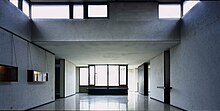La Vigna International Library
| La Vigna International Library | |
|---|---|

|
|
| founding | 1981 |
| Duration | 50,000 volumes |
| Library type | Specialized library |
| place | Vicenza |
| ISIL | IT-VI0154 |
| Website | http://www.lavigna.it/de/ |
Centro di Cultura e Civiltà Contadina - Biblioteca Internazionale La Vigna is a documentation center for agriculture and oenology . It is one of the most important institutes for ampelography worldwide.
The “La Vigna International Library” is located in Vicenza at 3 Contrà Porta Santa Croce, in the Palazzo Brusarosco, a 19th century building restored by the architect Carlo Scarpa .
History of the institution
The "Centro di Cultura e Civiltà Contadina - Biblioteca Internazionale La Vigna" was founded by the Vicenza entrepreneur Demetrio Zaccaria , who had been interested in wine and viticulture since the mid-1950s. The first book in his collection was the "Dictionary of Wine" by Frank Schoonmaker, which started a 20 year collecting activity that resulted in an international library for researchers and enthusiasts. Demetrio Zaccaria took part in international gatherings, made important connections around the world and started buying old and rare books. The meeting with André Simon in London, the founder of the "International Wine and Food Society" and specialist author for gastronomy and wine, was important.
In the 1970s Zaccaria moved his books from Toscolano on Lake Garda, where he had lived since 1958, to Vicenza. In 1980 he acquired the Palazzo Brusarosco, now the seat of the library. At the age of seventy he donated the palazzo and its collection of around 10,000 works to the Vicenza municipality because he was concerned about the future of his collection. Zaccaria took over the office of general secretary of the “Centro di Cultura e Civiltà Contadina” and was the first director of the “Biblioteca Internazionale La Vigna”. Demetrio Zaccaria died in 1993.
Library headquarters

The documentation center and library are located in the Palazzo Brusarosco. According to the sparse historical sources, there was a house here that was built within the Scaliger city wall in the 15th century. Ottone Calderari enlarged the house in the 18th century, in 1833 the new owner Orazio Brusarosco ordered the restoration of the arcade and the facade by the architect Tommaso Becega. During the Second World War, the palace was damaged by Allied bombing.
In the sixties the Vicenza lawyer Ettore Gallo bought the building. A renovation was carried out under Carlo Scarpa: The basement was converted into an apartment, which is now used as the library's administration rooms, the second floor houses the actual library, the office and apartment Ettore Gallos were on the second floor and further living rooms in the attic.
The spaciously designed and light-flooded former Gallos apartment is now used for exhibitions and meetings.
Collections
The library contains around 50,000 works, most of them on agriculture , viticulture , beekeeping , olive oil and honey production and gastronomy. It is constantly being expanded with new publications, antiquarian books and donations.
The collection of historical literature includes the most important specialist Italian literature printed between the 16th and 17th centuries. Her treasures include the first modern treatise on gastronomy De honesta voluptate by Bartolomeo Platina from 1530 and several editions of De naturali vinorum historia by the Roman doctor Andrea Bacci (1596).
The physical, philological, historical, medical and chemical treatise Ampelographia (1660) by the German doctor Philipp Jakob Sachs von Löwenheim begins the series of treatises on ampelography, which makes the library a supra-regional reference point. Dithyrambs are another part of the collection: the library owns 63 copies of the 82 surviving copies of Il Bacco in Toscana by Francesco Redi .
The most important sub-collections are:
- Fondo IRA collection (Ispettorato Regionale per l'Agricoltura), around 2500 works from the end of the 19th to the beginning of the 20th century on agriculture in the Vicenza and Veneto area. This collection was a gift from the “Ispettorato Regionale dell'Agricoltura”.
- Fondo Fagiani collection , 1100 titles on the Italian and European economy and the history of agriculture. It is a gift from the Vicenza historian Fernando Fagiani.
- Fondo Caproni collection, 6,500 titles on Italian agricultural policy between 1922 and 1943 and on the subject of reclamation . The collection also includes some historical publications on agriculture, such as "Della agricoltura" by Rutilio Tauro Palladio , printed in Venice in 1528. This collection was bought in 1997 by the heirs of Federico Capronis, partner in the airline “Industrie Aeronautiche Caproni”.
- Fondo Galla collection , around 400 books and magazines from the 20th and 21st centuries on the subject of hunting , including specialist books on trapping and hunting techniques, numerous diaries and hunting reports, valuable picture books on birds and numerous encyclopedias. The oldest and most remarkable book in the collection is "Del modo di piantare e custodire una ragnaja e di uccellare a ragna", published in 1790 and incorrectly attributed to Bernardo Davanzati (1529–1606) and printed in his "Opera Omnia" . The author of the book, in which the art of building bird traps and catching birds in these traps is described in detail, is GA Popoleschi. The collection was donated to the library in 2007 by Mariano Galla.
Visiting associations
The Documentation Center maintains contacts with the following societies that deal with viticulture, gastronomy and environmental issues:
- Associazione “Amici dei Parchi” [1]
- Accademia italiana “La vite e il vino” [2]
- Accademia italiana della cucina - Sezione di Vicenza [3]
- Gruppo micologico Bresadola - Vicenza [4]
